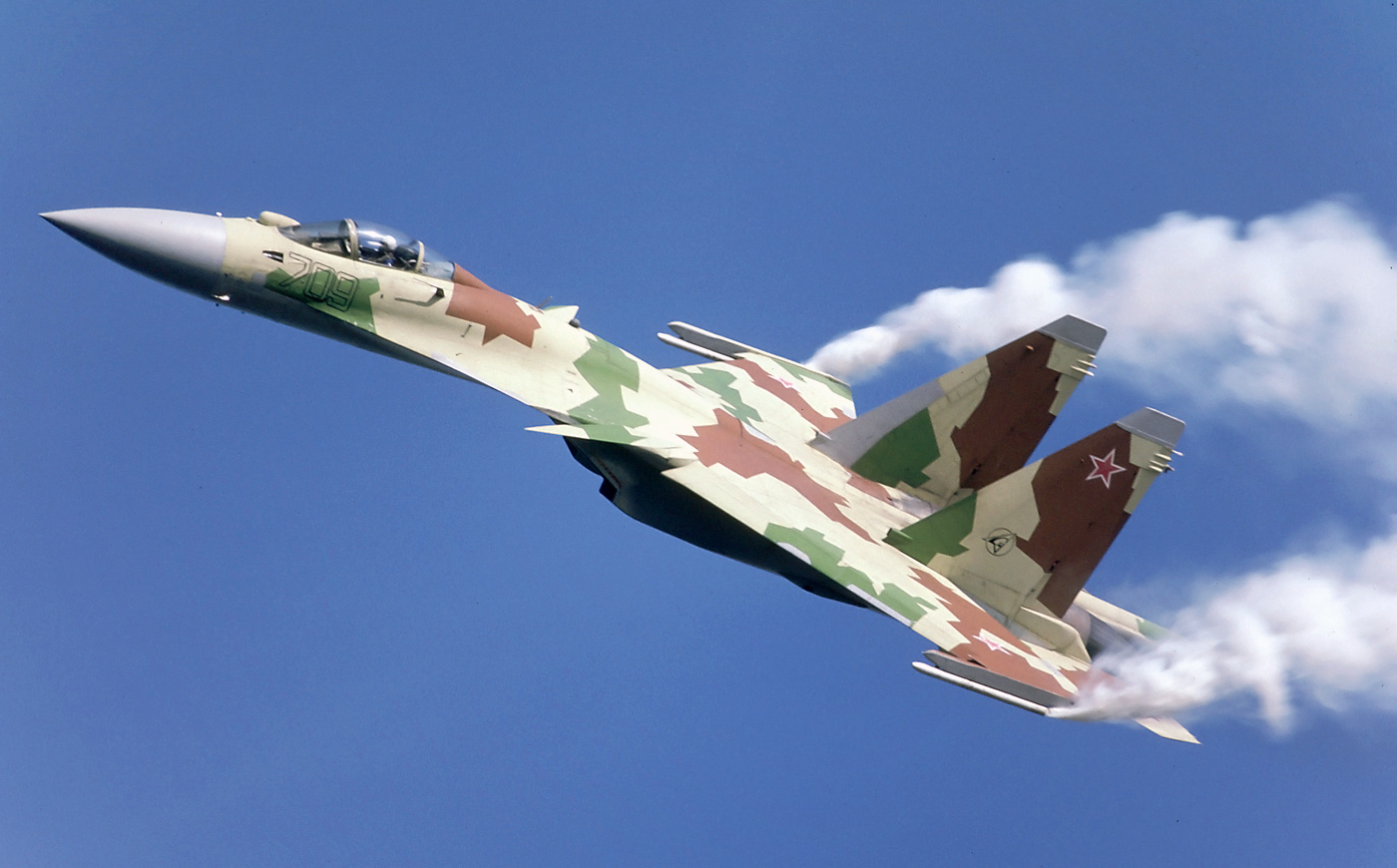Sukhoi 30 Cost - The Sukhoi Su-30 (Russian: Сухой Су-30; NATO reporting name: Flanker-C/G/H) is a twin-engine, two-seat fighter aircraft manufactured in the Soviet Union by Russia's Sukhoi Aviation Corporation. It is a multirole fighter for air-to-air, air-to-air and interdiction missions.
The Su-30 was launched by Sukhoi as an internal development project within the Sukhoi Su-27 family. The two-seater Su-27UB was developed into the Su-27PU heavy interceptor. The design was revised and the Su-27PU was converted to the Su-30 by the Russian Ministry of Defense in 1996. From the Flanker family, the Su-27, Su-30, Su-33, Su-34 and Su-35 have been ordered by the Russian Ministry of Defense for limited or serial production. Later, different export requirements split the Su-30 into two separate versions produced by competing organizations: KnAAPO and Irkut Corporation, both under the umbrella of the Sukhoi Aerospace Group.
Sukhoi 30 Cost
![]()
KnAAPO produces the Su-30MKK and Su-30MK2, which were designed and sold to China, and later to Indonesia, Uganda, Venezuela and Vietnam. Due to KnAAPO's involvement from the early stages of Su-35 development, this is essentially a two-seat version of the mid-1990s Su-35. The Chinese opted for an older but lighter radar to eliminate Canadians in exchange for increased payload. This fighter has both air superiority and attack capability, which is almost similar to the American fighter F-15E Strike Eagle.
The Air Force Wants To Retire The F 22 To Fund The Ngad Fighter
Irkut has traditionally serviced Soviet air defense aircraft, and in the early years of Flanker development was responsible for the production of the Su-27UB, a two-seat trainer version. When India showed interest in the Su-30, Irkut offered the multirole Su-30MKI, derived from the Su-27UB, modified with appropriate combat avionics. In addition to ground attack capabilities, the series adds features for an air superiority role, such as canards, thrust vectoring and long-range phased array radar. Its derivatives include the Su-30MKM, MKA and SM for Malaysia, Algeria and Russia. The Russian Air Force operates several Su-30s and has also ordered the Su-30SM variant.
While the original Su-27 had a good range, it still did not have enough range for the Soviet Air Defense Forces (PVO, as opposed to VVS - Soviet Air Force). Air defense forces were needed to cover the vast expanses of the Soviet Union. Therefore, in 1986, the development of the Su-27PU began, an improved variant of the Su-27 that could serve as a long-range interceptor or an airborne command post.
As the basis for the Su-27PU, the training two-seater Su-27UB was chosen, which had the performance of a single-seater Su-27 with seats for two crews. A "proof of concept" demonstrator flew on June 6, 1987, and this success led to the start of development work on two Su-27PU prototypes. The first Su-27PU flew to Irkutsk on 31 December 1989, and the first of three pre-production models flew on 14 April 1992.
A Russian Air Force Sukhoi Su-30LL flies along the runway of Zhangjiajie Hehua Airport very close to the ground with pilot Anatoly Kovchor
Sukhoi Su 35
The Su-30 is a multipurpose fighter. It has a two-seater cockpit with an air brake behind the canopy. It can act as an air superiority fighter and as a strike fighter.
The integrated aerodynamic configuration, combined with the ability to control the thrust vector, results in high maneuverability and unique take-off and landing characteristics. Equipped with a digital fly-by-wire system, the Sukhoi 30 is capable of some very advanced maneuvers, including the Cobra Pugachev and Tail Slide. These maneuvers quickly decelerate the aircraft, causing the pursuit fighter to overfly, and also breaking the Doppler radar lock, as the relative speed of the aircraft falls below the threshold at which the signal is registered by the radar.
Some variants of the Su-30, notably the Su-30MKI and its derivatives including the Su-30MKM and Su-30SM, are equipped with canaries to increase maneuverability as well as to compensate for the heavier N011M radar rods and nose mission system. The canards and modified LERX help control vortices and increase the aircraft's angle of attack limit, but also add drag and reduce top speed to Mach 1.75.

Like the basic Sukhoi-27S/P, the Su-30's powerplant has two low-burn Saturn AL-31F bypass turbofans fed through intake ramps. Two AL-31Fs, each with 122.6 kN (27,600 lb ft) full afterburner thrust for speeds up to Mach 2 in level flight and 1,350 km/h at low altitude for non-canned variants. An inclined thrust vector is used in some variants to increase maneuverability.
India, France Gear Up For Mega Garuda Exercise From July 1; Iaf Personnel To Get A Closer Look At Rafale Jets
The Su-30MK is capable of a 4.5-hour combat mission with a range of 3,000 km with a typical fuel reserve of 5,270 kg. An airborne refueling system extends the range to 5,200 km (3,200 miles) or a flight duration of up to 10 hours at cruise altitude.
The aircraft has autopilot capability in all phases of flight, including low-altitude flight in ground tracking radar mode and single and group combat against air and land/sea targets. The automatic control system connected to the navigation system ensures the route overflight, the approach to the target, the return to the airport and the approach for landing in automatic mode.
In the period from 1994 to 1996, the first batch of five Su-30 (Su-27PU) main combat aircraft contracted by the Russian Ministry of Defense was delivered to the 54th Guards Fighter Aviation Regiment based at Savaslika Air Base.
After the disbandment of the regiment in 2002, the aircraft became part of the 4th center for combat recruitment and retraining of personnel in Lipeck, where they were mainly flown by the Russian Falcon aerobatic team.
An In Depth Analysis Of Why The Sukhoi Su 35 Is The Most Overhyped 4th Generation Fighter Aircraft
No other orders of this type have been issued. However, the Russian Ministry of Defense was impressed by the speed of performance of the exported Su-30MKIs and ordered a total of 60 Su-30SM fighters under two contracts signed in March and December 2012.
By 2015, the 31st Fighter Aviation Regiment, the last aviation regiment of the Russian Aerospace Forces to fly the Soviet-made MiG-29A/UB (izdeliye 9.12/9.13), was fully armed with twenty new Su-30SM fighters.
This brought the total number up to 116 people (88 people in the air force and 28 people in the navy).

Eight new aircraft were delivered to the Russian Knights aerobatic team in October and November 2016, replacing six Su-27 fighter jets. These aircraft are located at the Kubinka Air Base in the Moscow Region.
Contract Of The Century\
During the MAKS 2017 International Aerospace Show, it was announced that the Ministry of Defense of Russia and the Irkut Corporation are working on the modernization of the Russian Su-30SM fighters with the new "Su-30SM1" standard. The purpose of this modernization is to improve the aircraft's avionics and armament.
In August 2019, the Russian Ministry of Defense first signed a contract for an undisclosed number of Su-30SM2 (hereinafter referred to as Su-30SM1) modern combat aircraft. The first delivery to the Russian Aerospace Forces is planned for the end of 2020, and serial deliveries will begin in 2021. The aircraft will receive the N035 Irbis radar and the AL-41F1S Su-35S, which is intended to standardize and reduce the operational costs of the two. The aircraft's armament types will also use the new KAB-250 aerial bombs and Kh-59MK2 radar-evading cruise missiles. It is planned to modernize all Russian Sukhoi-30 SM aircraft to the SM2 standard.
On August 25, 2020, a contract for 21 modern Su-30SM2 aircraft for the Russian Naval Aviation was signed at the military-technical forum "ARMIJA-2020".
In September 2015, Russia first deployed Su-30SM fighters to Basel al-Assad International Airport in Latakia, Syria. At least four Su-30SM fighters were spotted on the satellite image.
Top U.s. Official: U.s. Would Block Sale Of Russian Su 30 Aircraft To Iran
The Su-30SM was originally tasked with air escort for Russian attack aircraft and strategic bombers, but also performed air-to-ground missions. On March 21, 2017, rebel forces launched a new operation in Hama province. A few days later, a video was released showing a Russian Air Force Su-30SM attacking ground targets with unguided air-to-surface missiles in a dive against the rebels.
On May 3, 2018, a Russian Air Force Sukhoi Su-30 crashed shortly after takeoff from Hmeimim Air Base, killing both crew members.
Russian Su-30SM and Su-35s fighters were used for air superiority missions during the war. Overall, at least a few air-to-air victories over Ukrainian jets were recorded

A Russian Sukhoi Su-30 was destroyed on the ground by Ukrainian OTR-21 Tochka missiles fired during the attack on the Milrov Air Base.
Keychain From The Russian Su 30 Attack Aircraft Shot Down In Ukraine
On March 5, 2022, a Russian Navy Su-30SM aircraft was shot down in the Bashtanka region of Mykolaiv Oblast. The pilot is captured.
On March 13, 2022, another plane disappeared over Ukraine. The pilot, Kosik Serhi Serhiyovic, survived and was captured.
On August 9, 2022, explosions at Saki Air Base in Novodoryuk, Crimea destroyed at least three Su-30s and damaged one.
On August 18, Su-30SM with serial number RF-81771, its wreckage was registered in the Kharkiv region in the direction of Izium.
Gaijin Logic In Tech Trees
Pilot Lieutenant Colonel Sergey Kusik was arrested. Another Su-30SM with serial number RF-81773 red marking 62 was discovered by Ukrainian forces near Izium, Kharkiv. There is no information about the fate of the pilot.
The first talks about the purchase of a new fighter for the Indian Air Force began in 1994. A year later Sukhoi Design Bureau began work on a new fighter based on the original Su-30 design, which later became the Su-30MK (Modernizirovannyi Kommercheskiy - Modernized Commercial) and finally the Su-30MKI (Modernizirovannyi Kommercheskiy Indiski - Modernized Commercial Indian).
On November 30, 1996, the Russian state enterprise Rosvooruzhie (now Rosoboronexport) and the Indian Ministry of Defense signed a contract for the development and production of 8 Su-30K and 32 Su-30MKI for the Indian Air Force.

In March - July
Cag Flags Drdo Declaring 20 Mission Mode Projects 'successful' Despite Not Achieving Objectives
Sig p365 tulster holster, sig p365 iwb holster, sig holsters p365, sig p365 sas holster, sig p365 xl holster, sig p365 hybrid holster, appendix holster sig p365, safariland holster sig p365, sig p365 belt holster, sig p365 holster, sig p365 purse holster, sig sauer p365 holster

0 Comments